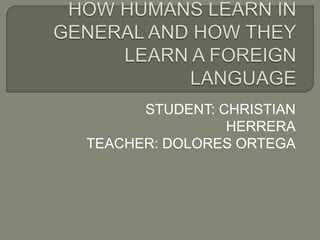
HOW HUMANS LEARN IN GENERAL AND HOW THEY LEARN A FOREIGN LANGUAGE
- 2. The cognitive domain of humans behavior is of key importance in the acquisition of both: a first and a second language. The processes of perceiving, attending, storing and recalling are central to the task of internalizing a language.
- 4. • Ausubel's believes that learning of new knowledge relies on what is already known. That is, construction of knowledge begins with our observation and recognition of events and objects through concepts we already have. We learn by constructing a network of concepts and adding to them. • Ausubel also stresses the importance of reception rather than discovery learning, and meaningful rather than rote learning.
- 5. Roger is not as concerned about the actual cognitive process of learning because he feels if the context for learning is properly created, then human beings will, in fact, learn everything they need to.
- 6. 1. Signal learning 2. Stimulus-Response learning 3. chaining 4. Verbal asociation 5. Multiple Descrimination 6. Concept learning 7.Principle learning 8. Problem solving
- 7. The Second Language learning in general occurs in the total language process that can be further efficiently categorized and sequenced in congnitive terms by means of the eight types of learning
- 8. Transfer: It has to do with the carryover of previous knowledge to subsequent learning. Ex: positive and negative transfer Interference: A previous item is incorrectly transferred or associated with an item to be learned. Overgeneralization: Meaningful learning is generalization. It is a process that occurs as the second language learner acts within the target language, generalizing a particular rule or item in the second language.
- 9. • Inductive reasoning: one stores a number of specific instances and induces a general law that governs the specific instances. • Deductive reasoning: is a movement from a generalization to specific instances.
- 10. Aptitude: some people have a better aptitude to learn a second language. Risk-taking, behavior, memory efficiency, intelligent guessing, and ambiguity tolerance are some aptitudes cited. • Intelligence: according to Howard Gardner (1983) there are seven forms of intelligence: 1. Linguistic 2. Logica-mathematical 3. Spatial 4. Musical 5. Bodily-kinesthetic 6. Interpersonal 7. Intrapersonal
- 11. There are three types of smartness: 1. Componential ability for analytical thinking 2. Experiential ability to engage in creative thinking, combining disparate experiences in insightful ways. 3. Contextual ability: “Street smartness” that enables people to “play the game” of manipulating their environment.
- 12. 1.Audiolingualism 2. Suggestopedia 3. The silent way 4. Total physical response 5. The natural approach
- 13. Comprehensible input is the exposure to interesting and understandable listening and reading material. We acquire language when we understand messages.